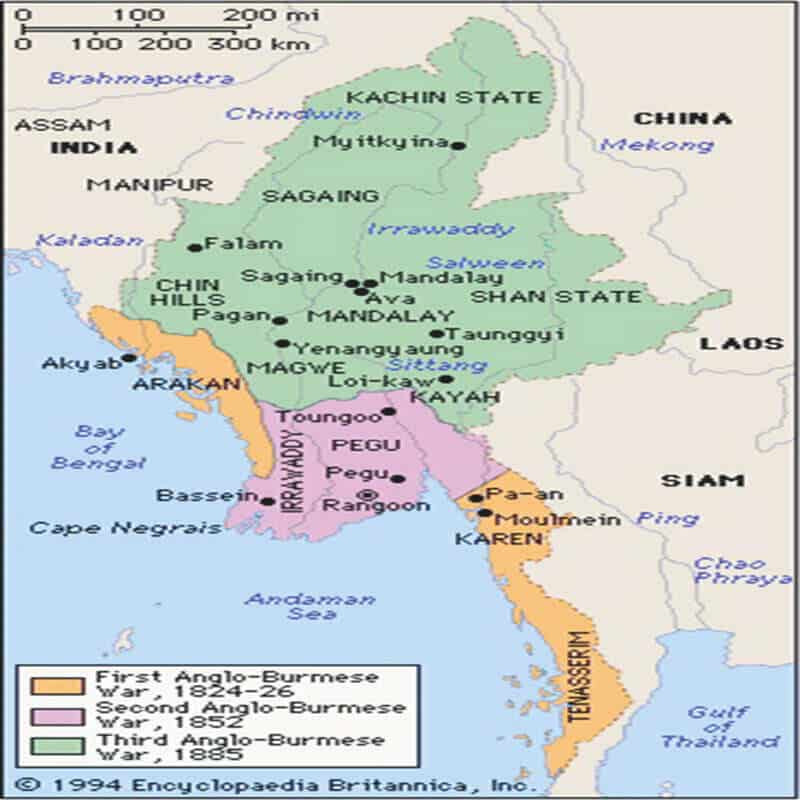
Anglo-Burmese wars (1824-1885) were British India’s most expensive and longest wars. The war began when the expanding empire of the Konbaung dynasty knocked the borders of British India in the northeastern region. Read here to learn more about the three Anglo-Burmese Wars.
The Burmese Konbaung dynasty was on an expansion spree in the 1800s hence had regular conflicts at the frontiers. Their expansionism brought them closer to the borders of British Indian regions in the northeastern areas.
While the British already were eyeing Burma to expand their trade, as well as take advantage of the ample amount of timber from the forests. They also wanted to curb the growing French influence in Burma (present-day Myanmar).
A brief history of Burma (Myanmar)
The history of Myanmar dates back to about 13000 years ago when there were settlements near the Irrawaddy River. The old civilization gradually adopted Theravada Buddhism which migrated to Burmese land from India.
Early in the 9th century, the Bamar people arrived in the upper Irrawaddy valley. They later founded the Pagan Kingdom (1044–1297) which united the Irrawaddy valley and its surroundings for the first time.
After the First Mongol invasion of Burma in 1287, several small kingdoms, of which the Kingdom of Ava, the Hanthawaddy Kingdom, the Kingdom of Mrauk U, and the Shan States were principal powers, came to dominate the landscape.
In the late 16th century, the Toungoo dynasty (1510–1752) reunified the country and founded the largest empire in the history of Southeast Asia for a brief period.
Later in the late 18th century, the Konbaung dynasty (1752–1885) restored the kingdom and continued the Taungoo reforms that increased central rule in peripheral regions and produced one of the most literate states in Asia.
The dynasty also went to war with all its neighbors. The Anglo-Burmese wars (1824–85) eventually led to British colonial rule.
Burma was unified between 1752-60 by King Alaungpaya of the Konbaung dynasty. His successor, Bodawpaya ruled from Ava on the Irrawaddy River invaded nearby territories of Siam and repelled Chinese invasions, and eventually reached British India’s borders.
First Anglo-Burmese War (1824-26)

The Konbaung dynasty conquered the Arakan region in 1785, and the present-day Manipur region by 1813 brought the Burmese border into contact with British India.
1822: Burma conquered Assam, which led to conflicts along the ill-defined borders of Bengal and Burma. The Arakanese rebels hiding in Chittagong constantly raided the Burmese Arakan regions.
1823: The clashes reached the island of Shalpuri which was earlier occupied by Burma but was under British control later. The British rejected the Burmese proposal to neutralize the island.
1824: The British declared war on Burma officially and sent naval forces into the Burmese mainland through Yangon (Rangoon) harbor (Battle of Yangon).
1825: The British entered the capital Ava where the famous Burmese general Maha Bandula was killed in action. But the Burmese resistance was tough, especially their guerrilla warfare in jungles.
The constant rains and virulent diseases of forests killed more soldiers than the actual war and a peace treaty was agreed upon.
1826: Treaty of Yandabo was signed to bring the first Anglo-Burmese war to an end. Burma lost its occupied territories of Assam, Manipur, and Arakan. They also had to cede a lot of their coastline to the British.
They also had to accept a British resident at Ava but a Burmese envoy was posted at Calcutta too.
Second Anglo-Burmese War (1852-53)
The second war was caused by the British commercial greed as they began to exploit the vast forests of upper Burma for timber. They wanted to expand their market for the sale of cotton products as well.
Lord Dalhousie was the governor-general of India (1848-56) who provoked this war. He dispatched Commodore Lambert to Burma over several minor issues related to the previous treaty. The Burmese had started blocking commercial exploitation through the coasts.
1852: The British launched an attack on Burma over a petty complaint by British merchants and Lambert provoked a naval confrontation over this. The British sea strength was superior and they captured Rangoon and eventually annexed the Pegu province which was renamed Lower Burma.
The war resulted in a palace revolution in Burma, with King Pagan Min (1846–1853) being replaced by his half-brother, Mindon Min (1853–1878).
Third Anglo-Burmese War (1885-86)
King Mindon tried to modernize the Burmese state and economy to ensure its independence, and he established a new capital at Mandalay, which he proceeded to fortify.
To offset the British, he entertained envoys from France and sent his emissaries there. King Mindon died in 1878 and his son Thibaw took over the reign.
During the reign of Thibaw (1878–85), the British were willing to ignore Upper Burma and concentrate on French moves in Laos, Vietnam, and Yunnan.
1885: King Thibaw signed a commercial trade treaty with the French which alarmed the British.
This action provoked British forces to strike. The annexation of Upper Burma was announced in 1885, ending the Konbaung dynasty and Burmese independence.
The regions under King Thibaw were added to British Indian Empire after his surrender.
Even though the Third Anglo-Burmese War formally ended before it had even developed, but resistance to British rule continued for another four years. The Burmese army officials carried out widespread guerrilla warfare from the jungles while the people of lower Burma also rose in rebellion.
Impact of Anglo-Burmese wars
The Burmese resistance took the British almost five years to suppress, the expenses of which were taxed on the Indians.
The remnants of the Anglo-Burmese were carried in people’s minds for years. after World War I (1914-18), a modern nationalist movement arose in Burma. There were campaigns boycotting British goods and administration with demand for home rule.
Burmese nationalism caused the British to separate Burma from India in 1935 to weaken the struggle. In 1937, Burma became a separately administered colony of Great Britain.
The Burmese nationalist movement reached heights under the leadership of Aung San during World War II. Burma finally won its independence on 4 January 1948.
-Article written by Swathi Satish






Leave a Reply